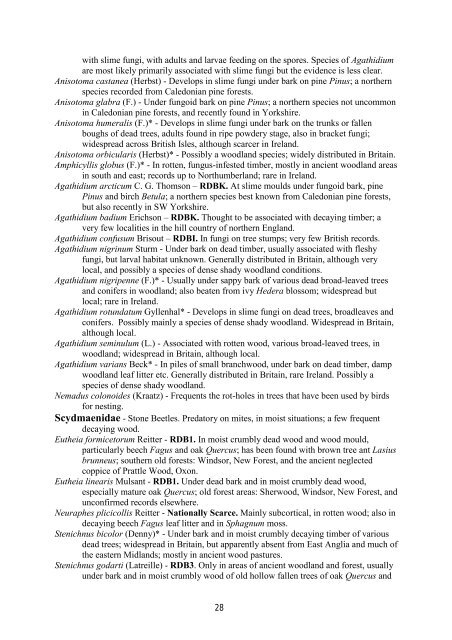Crustacea: Copepoda - Cerambycoidea.com
Crustacea: Copepoda - Cerambycoidea.com
Crustacea: Copepoda - Cerambycoidea.com
Create successful ePaper yourself
Turn your PDF publications into a flip-book with our unique Google optimized e-Paper software.
with slime fungi, with adults and larvae feeding on the spores. Species of Agathidium<br />
are most likely primarily associated with slime fungi but the evidence is less clear.<br />
Anisotoma castanea (Herbst) - Develops in slime fungi under bark on pine Pinus; a northern<br />
species recorded from Caledonian pine forests.<br />
Anisotoma glabra (F.) - Under fungoid bark on pine Pinus; a northern species not un<strong>com</strong>mon<br />
in Caledonian pine forests, and recently found in Yorkshire.<br />
Anisotoma humeralis (F.)* - Develops in slime fungi under bark on the trunks or fallen<br />
boughs of dead trees, adults found in ripe powdery stage, also in bracket fungi;<br />
widespread across British Isles, although scarcer in Ireland.<br />
Anisotoma orbicularis (Herbst)* - Possibly a woodland species; widely distributed in Britain.<br />
Amphicyllis globus (F.)* - In rotten, fungus-infested timber, mostly in ancient woodland areas<br />
in south and east; records up to Northumberland; rare in Ireland.<br />
Agathidium arcticum C. G. Thomson – RDBK. At slime moulds under fungoid bark, pine<br />
Pinus and birch Betula; a northern species best known from Caledonian pine forests,<br />
but also recently in SW Yorkshire.<br />
Agathidium badium Erichson – RDBK. Thought to be associated with decaying timber; a<br />
very few localities in the hill country of northern England.<br />
Agathidium confusum Brisout – RDBI. In fungi on tree stumps; very few British records.<br />
Agathidium nigrinum Sturm - Under bark on dead timber, usually associated with fleshy<br />
fungi, but larval habitat unknown. Generally distributed in Britain, although very<br />
local, and possibly a species of dense shady woodland conditions.<br />
Agathidium nigripenne (F.)* - Usually under sappy bark of various dead broad-leaved trees<br />
and conifers in woodland; also beaten from ivy Hedera blossom; widespread but<br />
local; rare in Ireland.<br />
Agathidium rotundatum Gyllenhal* - Develops in slime fungi on dead trees, broadleaves and<br />
conifers. Possibly mainly a species of dense shady woodland. Widespread in Britain,<br />
although local.<br />
Agathidium seminulum (L.) - Associated with rotten wood, various broad-leaved trees, in<br />
woodland; widespread in Britain, although local.<br />
Agathidium varians Beck* - In piles of small branchwood, under bark on dead timber, damp<br />
woodland leaf litter etc. Generally distributed in Britain, rare Ireland. Possibly a<br />
species of dense shady woodland.<br />
Nemadus colonoides (Kraatz) - Frequents the rot-holes in trees that have been used by birds<br />
for nesting.<br />
Scydmaenidae - Stone Beetles. Predatory on mites, in moist situations; a few frequent<br />
decaying wood.<br />
Eutheia formicetorum Reitter - RDB1. In moist crumbly dead wood and wood mould,<br />
particularly beech Fagus and oak Quercus; has been found with brown tree ant Lasius<br />
brunneus; southern old forests: Windsor, New Forest, and the ancient neglected<br />
coppice of Prattle Wood, Oxon.<br />
Eutheia linearis Mulsant - RDB1. Under dead bark and in moist crumbly dead wood,<br />
especially mature oak Quercus; old forest areas: Sherwood, Windsor, New Forest, and<br />
unconfirmed records elsewhere.<br />
Neuraphes plicicollis Reitter - Nationally Scarce. Mainly subcortical, in rotten wood; also in<br />
decaying beech Fagus leaf litter and in Sphagnum moss.<br />
Stenichnus bicolor (Denny)* - Under bark and in moist crumbly decaying timber of various<br />
dead trees; widespread in Britain, but apparently absent from East Anglia and much of<br />
the eastern Midlands; mostly in ancient wood pastures.<br />
Stenichnus godarti (Latreille) - RDB3. Only in areas of ancient woodland and forest, usually<br />
under bark and in moist crumbly wood of old hollow fallen trees of oak Quercus and<br />
28

















